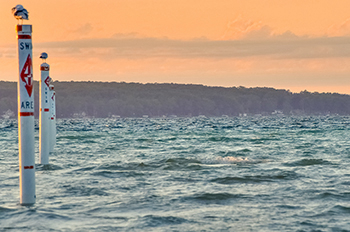As Swim Buoys at State Parks are Removed, Swim Area Designation Expires

As the weather cools and the days shorten, the Michigan Department of Natural Resources begins the process of removing swim buoys from many state park beaches.
Swim buoys help mark the boundaries of a swim area, which are established to help identify locations with shallower water (less than 5 feet) and lower risks of dangerous currents and waves. DNR staff inspects these areas approximately every two weeks and adjusts them as needed to maximize safety.
Once buoys are removed, the area is no longer considered a swim area. While the beach remains open to the public, swimming is not recommended.
Due to high winds, waves and rapidly changing water temperatures during the off-season, buoys typically are installed before the Memorial Day holiday weekend and are removed after Labor Day. On-shore rescue equipment, the flag system (Great Lakes only) and safety signage will remain along those sections of shoreline through at least Oct. 1.
“Swim buoys and beach flag warning systems start to be removed after Labor Day weekend due to changing weather patterns in September,” said Pat Whalen, Plainwell District supervisor for the DNR Parks and Recreation Division. “High winds, waves and unpredictable water temperatures can make it difficult for staff to perform the necessary inspections and remove the buoys within the usual 14-day time frame.”
Whalen also said that visitors should exercise caution when entering the water, as they would at any other nondesignated swim area.
A few other cautions:
- There are several hazards, such as strong longshore currents, rip currents and submerged objects, that can exist in the water all year long.
- There are no beach guards at state parks, so never swim alone, always keep close watch over children and bring U.S. Coast Guard-approved life jackets, especially for new and inexperienced swimmers.
- Water currents near piers, breakwalls and outlets of rivers can be extremely hazardous.
- Weather patterns, especially in the fall months, can change quickly. Check local weather reports and lake conditions and learn about different Great Lakes currents and how to escape them.
- As Great Lakes water temperatures drop, monitor swimmers for cold-water exposure, which can result in hypothermia. Water temperatures can change radically in 24 hours.
Visit Michigan.gov/BeachSafety for tips and information on safely visiting the Great Lakes, including state-designated swim beach locations, the beach flag warning system, Great Lakes currents (and how to escape them) and more.
For more information, contact the DNR’s Pat Whalen at 269-838-1196 or WhalenP1@Michigan.gov.




